Related Research Articles

Sudan, officially the Republic of the Sudan, is a country in Northeast Africa. It borders the Central African Republic to the southwest, Chad to the west, Egypt to the north, Eritrea to the northeast, Ethiopia to the southeast, Libya to the northwest, South Sudan to the south, and the Red Sea. It has a population of 45.7 million people as of 2022 and occupies 1,886,068 square kilometres, making it Africa's third-largest country by area and the third-largest by area in the Arab League. It was the largest country by area in Africa and the Arab League until the secession of South Sudan in 2011; since then both titles have been held by Algeria. Its capital and most populous city is Khartoum.

The history of Sudan refers to the territory that today makes up Republic of the Sudan and the state of South Sudan, which became independent in 2011. The territory of Sudan is geographically part of a larger African region, also known by the term "Sudan". The term is derived from Arabic: بلاد السودان bilād as-sūdān, or "land of the black people", and has sometimes been used more widely referring to the Sahel belt of West and Central Africa.

The Sudanese Armed Forces are the military forces of the Republic of the Sudan. In 2011, IISS estimated the forces' numbers at 109,300 personnel. The CIA estimates that the SAF may have up to 200,000 personnel.
Nubians are a Nilo-Saharan ethnic group indigenous to the region which is now Northern Sudan and Southern Egypt. They originate from the early inhabitants of the central Nile valley, believed to be one of the earliest cradles of civilization. In the southern valley of Egypt, Nubians differ culturally and ethnically from Egyptians, although they intermarried with members of other ethnic groups, especially Arabs. They speak Nubian languages as a mother tongue, part of the Northern Eastern Sudanic languages, and Arabic as a second language.
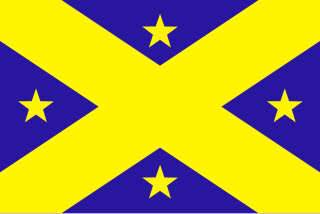
The Lado Enclave was a leased territory administered by the Congo Free State and later by the Belgian Congo that existed from 1894 until 1910, situated on the west bank of the Upper Nile in what is now South Sudan and northwest Uganda. Its capital was the town of Lado.
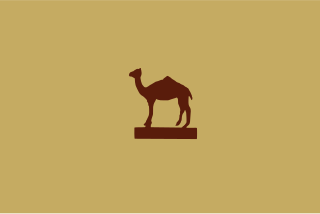
Kordofan is a former province of central Sudan. In 1994 it was divided into three new federal states: North Kordofan, South Kordofan and West Kordofan. In August 2005, West Kordofan State was abolished and its territory divided between North and South Kordofan States, as part of the implementation of the Comprehensive Peace Agreement between the Government of Sudan and the Sudan People's Liberation Movement. West Kordofan was reestablished in July 2013.
Banu Kanz, also known as Awlad Kanz, was a semi-nomadic Muslim dynasty of Arab descent that ruled the border region between Upper Egypt and Nubia between the 10th and 15th centuries. They were descended from the sons of sheikhs of the Arab Banu Hanifa tribe who intermarried with the princesses of the Beja Hadariba tribe. They gained official control over the region of Aswan, Wadi Allaqi and the frontier zone in the early 11th century when their chief, Abu al-Makarim Hibatallah, captured a major rebel on behalf of the Fatimid authorities. Abu al-Makarim was accorded the title Kanz al-Dawla by Caliph al-Hakim and his successors inherited the title. The Banu Kanz entered into conflict with the Ayyubids in 1174, during which they were defeated and forced to migrate southward into northern Nubia, where they helped accelerate the expansion of Islam in the mostly Christian region. They eventually assumed control of the Nubian Kingdom of Makuria in the early 14th century, but by the early the 15th century, they were supplanted by the Hawwara tribesmen dispatched by the Mamluks to combat the Banu Kanz. Their modern-day descendants are a Sudanese tribe known as the "Kunuz", who live in the far north of the country.

Alodia, also known as Alwa, was a medieval kingdom in what is now central and southern Sudan. Its capital was the city of Soba, located near modern-day Khartoum at the confluence of the Blue and White Nile rivers.
Amarar is a nomadic tribe of the Beja people inhabiting the mountainous country on the west side of the Red Sea Suakin northwards and Eritrea towards Sudan. Between them and the Nile are the Ababda and Bisharin Beja tribes and to their south dwell the Hadendoa. The country of the Amarar is called the Atbai. Their main location is in the Ariab region. The tribe is divided into four great families: (1) Weled Gwilei, (2) Weled Aliab, (3) Weled Kurbab Wagadab, and (4) the Amarar proper of the Ariab district. They claim to be of Quraysh blood and to be the descendants of an invading Arab army. Possibly descendants of some small bands of Quraysh Arabs may have made an inroad and were upon Islam. The Amarar are said to speak the purest form of the Beja language.
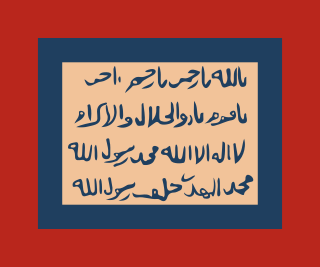
The Mahdist State, also known as Mahdist Sudan or the Sudanese Mahdiyya, was a state based on a religious and political movement launched in 1881 by Muhammad Ahmad bin Abdullah against the Khedivate of Egypt, which had ruled Sudan since 1821. After four years of struggle, the Mahdist rebels overthrew the Ottoman-Egyptian administration and established their own "Islamic and national" government with its capital in Omdurman. Thus, from 1885 the Mahdist government maintained sovereignty and control over the Sudanese territories until its existence was terminated by the Anglo-Egyptian forces in 1898.
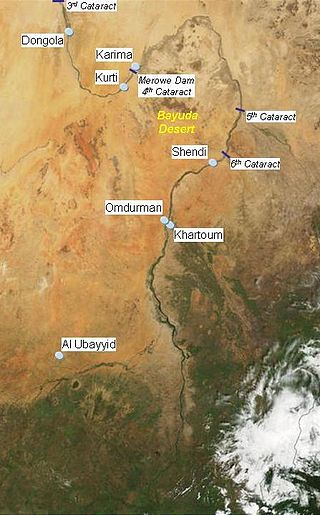
The Shaigiya, Shaiqiya, Shawayga or Shaykia are an Arabized Nubian tribe. They are part of the Sudanese Arabs and are also one of the three prominent Sudanese Arabs tribes in North Sudan, along with the Ja'alin and Danagla. The tribe inhabits the region of Dar al-Shayqiya, which stretches along the banks of the Nile River from Korti to the end of 4th Nile cataract and includes their tribal capital of Merowe Sheriq and parts of the Bayuda desert.
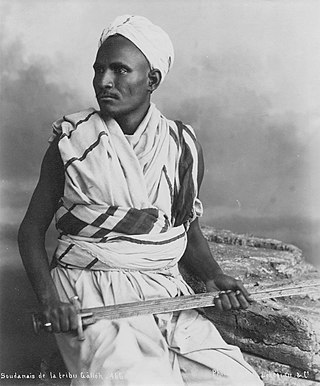
The Ja'alin, Ja'aliya, Ja'aliyin or Ja'al are a tribal confederation and an Arab or Arabised Nubian tribe in Sudan. The Ja'alin constitute a large portion of the Sudanese Arabs and are one of the three prominent Sudanese Arab tribes in northern Sudan - the others being the Shaigiya and Danagla. They trace their origin to Ibrahim Ja'al, an Abbasid noble, whose clan originally hailed from the Hejaz in the Arabian Peninsula and married into the local Nubian population. Ja'al was a descendant of al-Abbas, an uncle of Muhammad. The Ja'alin formerly occupied the country on both banks of the Nile from Khartoum to Abu Hamad. According to a source, the tribe allegedly once spoke a now extinct dialect of Nubian as late as the nineteenth century. Many Sudanese politicians have come from the Ja'alin tribal coalition.

Sudanese Arabs are the inhabitants of Sudan who identify as Arabs and speak Arabic as their mother tongue. Some of them are descendants of Arabs who migrated to Sudan from the Arabian Peninsula, although the rest have been described as Arabized indigenous peoples of Sudan of mostly Nubian, Nilo-Saharan, and Cushitic ancestry who are culturally and linguistically Arab, with varying cases of admixture from Peninsular Arabs. This admixture is thought to derive mostly from the migration of Peninsular Arab tribes in the 12th century, who intermarried with the Nubians and other indigenous populations, as well as introducing Islam. The Sudanese Arabs were described as a "hybrid of Arab and indigenous blood", and the Arabic they spoke was reported as "a pure but archaic Arabic". Burckhardt noted that the Ja'alin of the Eastern Desert are exactly like the Bedouin of Eastern Arabia.

Sudan has 4,725 kilometers of narrow-gauge, single-track railways. The main line runs from Wadi Halfa on the Egyptian border to Khartoum and southwest to El-Obeid via Sennar and Kosti, with extensions to Nyala in Southern Darfur and Wau in Western Bahr al Ghazal, South Sudan. Other lines connect Atbara and Sennar with Port Sudan, and Sennar with Ad-Damazin. A 1,400-kilometer line serves the Al Jazirah cotton-growing region. There are plans to rehabilitate rail transport to reverse decades of neglect and declining efficiency. Service on some lines may be interrupted during the rainy season.
The following is a timeline of the history of the city of Khartoum, Sudan.
Bedaria is an Arab tribe in Sudan. It is part of the Ja'alin tribe and constitutes a large portion of Sudanese Arabs. They speak Sudanese Arabic and are Sunni Muslims.

The Egyptian conquest of Sudan was a major military and technical feat. Fewer than 10,000 men set off from Egypt, but, with some local assistance, they were able to penetrate 1,500 km up the Nile River to the frontiers of Ethiopia, giving Egypt an empire as large as Western Europe.

South Sudanese nationality law is regulated by the Constitution of South Sudan, as amended; the South Sudanese Nationality Act and Nationality Regulations, and their revisions; and various international agreements to which the country is a signatory. These laws determine who is, or is eligible to be, a national of South Sudan. The legal means to acquire nationality, formal legal membership in a nation, differ from the domestic relationship of rights and obligations between a national and the nation, known as citizenship. Nationality describes the relationship of an individual to the state under international law, whereas citizenship is the domestic relationship of an individual within the nation. In South Sudan, nationality is often equated with ethnicity, despite recognition of the legal definitions. South Sudanese nationality is typically obtained under the principle of jus soli, i.e. by birth in South Sudan, or jus sanguinis, born to parents with South Sudanese ancestry. It can be granted to persons with an affiliation to the country, or to a permanent resident who has lived in the country for a given period of time through naturalization.
The Tunjur kingdom was a Sahelian precolonial kingdom in Africa between the 15th and early 17th centuries.

Sudanese nationality law is regulated by the Constitution of Sudan, as amended; the Sudanese Nationality Law, and its revisions; and various international agreements to which the country is a signatory. These laws determine who is, or is eligible to be, a national of Sudan. The legal means to acquire nationality, formal legal membership in a nation, differ from the domestic relationship of rights and obligations between a national and the nation, known as citizenship. Nationality describes the relationship of an individual to the state under international law, whereas citizenship is the domestic relationship of an individual within the nation. In Sudan, nationality is often equated with ethnicity, despite recognition of the legal definitions. Sudanese nationality is typically obtained under the principle of jus soli, i.e. by birth in Sudan, or jus sanguinis, born to parents with Sudanese nationality. It can be granted to persons with an affiliation to the country, or to a permanent resident who has lived in the country for a given period of time through naturalization.
References
- ↑ Davis, H. R. J. (1986). Rural Development in White Nile Province, Sudan: A Study of Interaction Between Man and Natural Resources, Issue 59. United Nations University. p. 66. ISBN 9280805797 . Retrieved September 8, 2015.
- ↑ Johnson, David Hamilton; Anderson, David M. (2011). The Ecology of Survival: Case Studies from Northeast African History. I.B. Tauris. p. 158. ISBN 978-1870915007 . Retrieved September 8, 2015.
- ↑ Kramer, Robert S.; Lobban Jr., Richard A.; Fluehr-Lobban, Carolyn (2013). Historical Dictionary of the Sudan. Scarecrow Press. pp. 148–331. ISBN 978-0810879409 . Retrieved September 8, 2015.
- ↑ Jousse, Hélène; Lesur, Joséphine (2011). People and Animals in Holocene Africa: Recent Advances in Archaeozoology. Africa Magna Verlag. p. 105. ISBN 978-3937248271 . Retrieved September 8, 2015.
- ↑ Manger, Leif O. (1994). From the Mountains to the Plains: The Integration of the Lafofa Nuba Into Sudanese Society. Nordic Africa Institute. p. 44. ISBN 9171063366 . Retrieved September 8, 2015.
- ↑ The Anglo-Egyptian Sudan, Volume 1. Sudan: H. M. Stationery Office. 1905. pp. 109–325. Retrieved September 8, 2015.
- ↑ Gleichen, Edward (1905). The Anglo-Egyptian Sudan: A Compendium Prepared by Officers of the Sudan Government, Volume 2. Sudan: H. M. Stationery Office. pp. 67–164. Retrieved September 8, 2015.